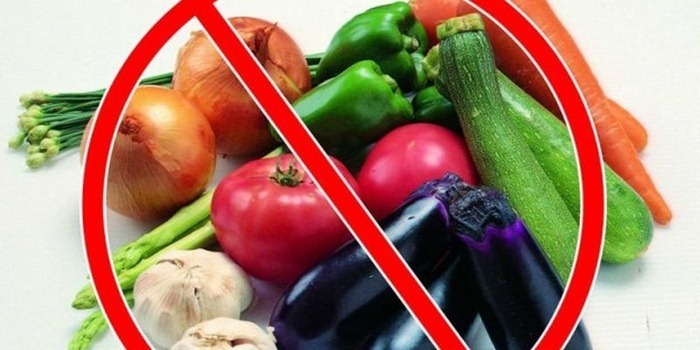Balsam is known to many as the home flower "Vanka wet", which gives off sweet drops of juice on the stem. Over the long history of plant cultivation, breeders of many countries have bred species and hybrid varieties that amaze with a variety of colors, the shape of petals. Perennial garden balsams have semi-double and double varieties of white, pink, red, lilac. In temperate latitudes, for landscape design of summer cottages, balsam is grown as an annual flower. Gardeners value culture for being decorative.
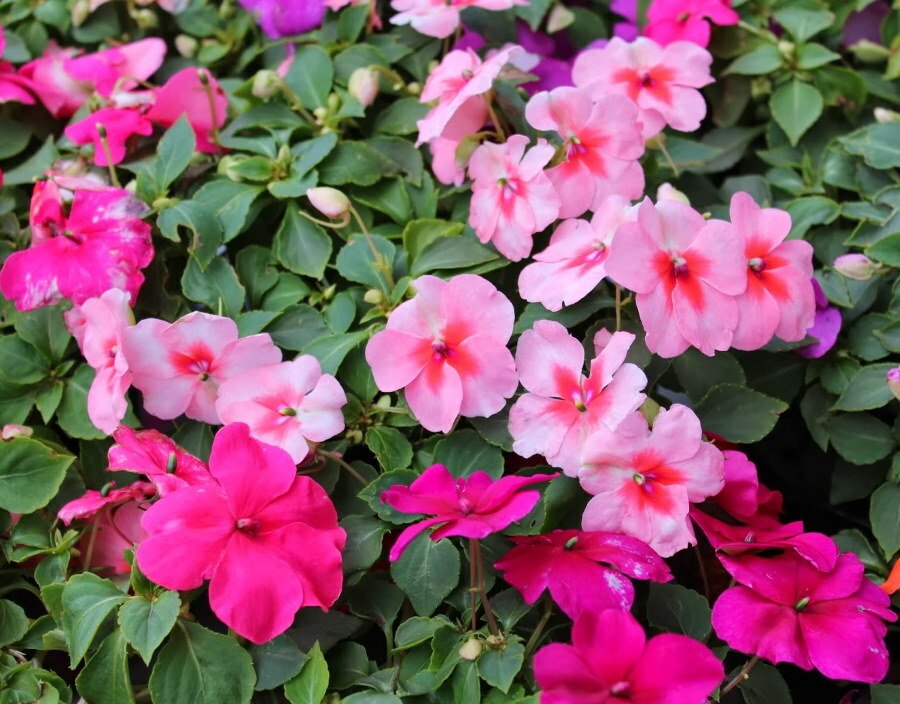
These rather unpretentious flowers are able to decorate the garden area all summer, right up to the very frosts.
The abundantly flowering bush feels great in a pot, easily adapts in the fresh air in the climatic conditions of the middle lane. Balsam-touch-me-not will decorate a flower garden, balcony, terrace, any garden. It is not difficult to take care of the crop, the plant reproduces vegetatively and by seeds.
The reasons for the popularity of balsam in landscape design
Content
- The reasons for the popularity of balsam in landscape design
- Description of popular varieties of garden flower
- Hawker's Balsam Impatiens hawkeri
- Balsam large-flowered Impatiens hookeriana or Impatiens grandis
- Impatiens balsamina
- Small-flowered Impatiens Praviflora
- Hybrid of Impatiens walleriana
- Rules and recommendations for planting seeds
- Features of flower care in a flower bed
- Photos of examples of the use of a perennial flower
- Video: Garden balsams in the open field
- Photo of balsams in the garden
This unique plant surprises with a variety of varieties, bushes ranging in size from 15 to 60 cm bloom throughout the growing season. The most decorative varieties have become a common attribute of suburban areas, parks, and the urban environment.
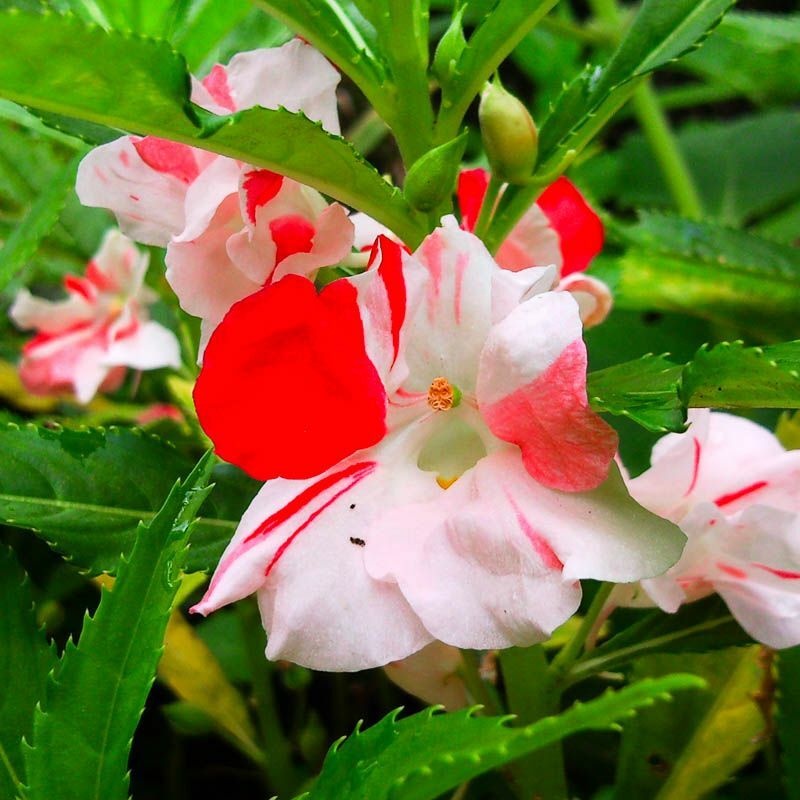
Garden balsam with two-tone flower color
The flower balsam photo garden with buds resembling roses is used for various purposes:
- registration of farmsteads;
- like a potted plant;
- as a tapeworm;
- for curb planting;
- in panoramic flower arrangements;
- in small flower beds;
- in mixborders.
In flower beds "touch-me-nots" begin to release buds in May, end flowering when cold weather sets in.
If the flowers are damaged by recurrent frosts, do not rush to throw out the bush. After feeding, pruning, the touch-me-not will continue to bloom.
Balsams are often used in decoration as a monoculture. Combining dwarf varieties up to 15 cm high with tall bushes reaching 50-60 cm, you can get a long-lasting flower arrangement of long flowering. By planting flowers of different shades, they create plant picturesque paintings. Varieties with pubescent stems are used for vertical spot gardening. Flowers feel great in hanging pots, boxes, flowerpots, containers.
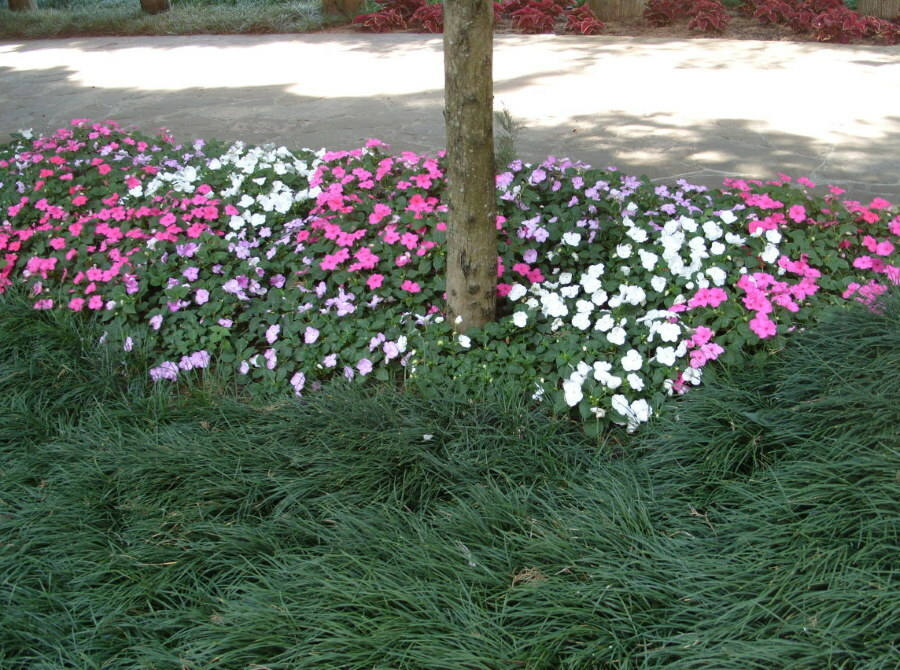
The ability of balsam to tolerate shading persistently makes it possible to use it to decorate tree trunks
More than 300 varieties of domestic and foreign selection are known. Wild varieties from various warm countries are used as mother plants. Ground cover and ampelous species of "Vanka wet" with lanceolate and oval leaves of different shades from light green to dark marsh or with greenery with a burgundy tint were bred.
Landscape designers appreciate balsam for its unpretentiousness, good survival rate, excellent seed germination.
Bushes transplanted into pots will delight with buds until next spring. They can be sources of cuttings for vegetative propagation. Root stems in water or moist soil, creating tropical conditions: high humidity and temperature.
Description of popular varieties of garden flower
Among the large variety of balsams, several popular varieties deserve the attention of gardeners.
Some types of flowers are positioned as annuals, in fact, any garden balsam in the winter garden, the apartment will grow all year round, delighting with buds. Culture has a short break at the end of January.
When choosing crops for decoration, the main criterion is light sensitivity. Some balsams fade in direct sunlight, buds require partial shade. Hybrids are more resistant to ultraviolet light, for example, Exotic Dwarf. The compact bush grows up to 20 cm, is distinguished by an abundance of large double buds, resembling a rose in appearance. Bred Dwarfs of various shades from white to purple. The flowers grow up to 4 cm in diameter, lanceolate or needle-like leaves are not visible behind the petals, the bush is a dense cap of flowers.
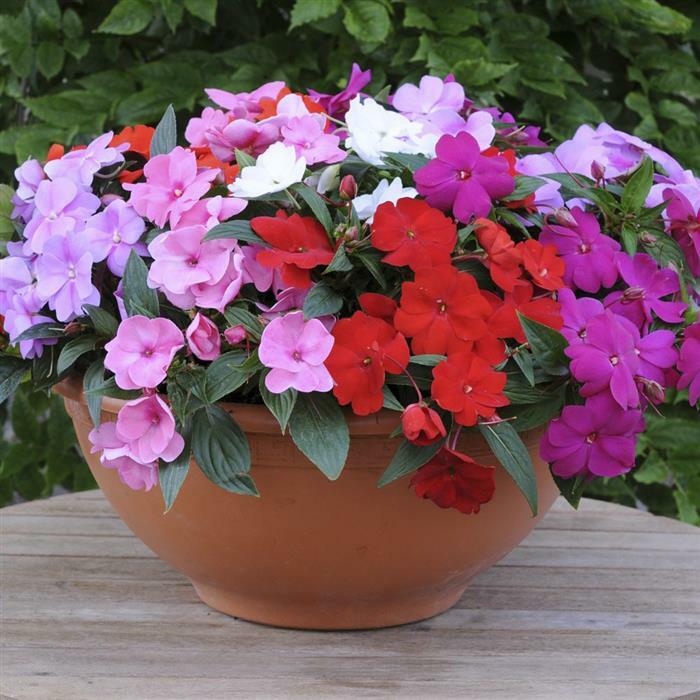
Balsam Exotic Dwarf in a garden flowerpot
The Carmelita variety is a tall-growing variety, taking into account the inflorescences, it grows up to 70 cm. It differs from other bush varieties in pyramidal inflorescences. Terry flowers, up to 4 cm in diameter. In temperate latitudes, the thermophilic Carmelita is planted in June. The flower can die with the first frost, and it gets sick with a significant decrease in night temperatures. It is more often grown in warm regions.
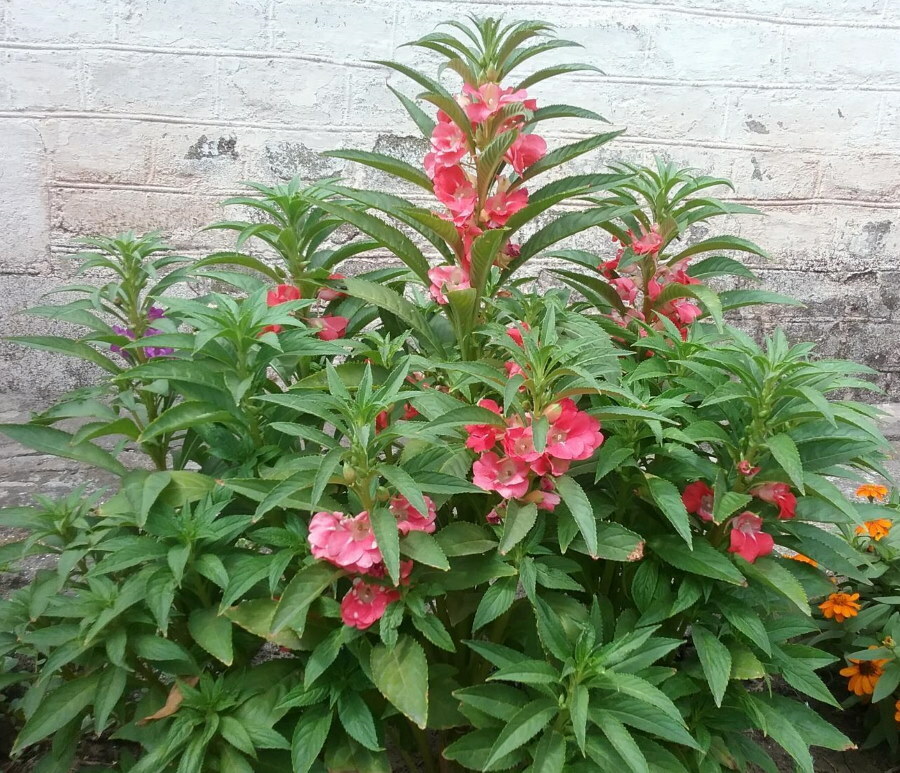
Balsam Carmelita with pale pink inflorescences
Impreza is distinguished by its variegated color, the pale pink single-layered buds have a surprisingly bright core. New Guinea hybrid varieties Divaro, Rainforest Exotic, Macarena, Jangle Rain and others are used for border planting. Medium-sized semi-double buds amaze with a variety of colors from pale cream to pronounced salmon and deep purple. Plants are resistant to sun color, can grow in partial shade.
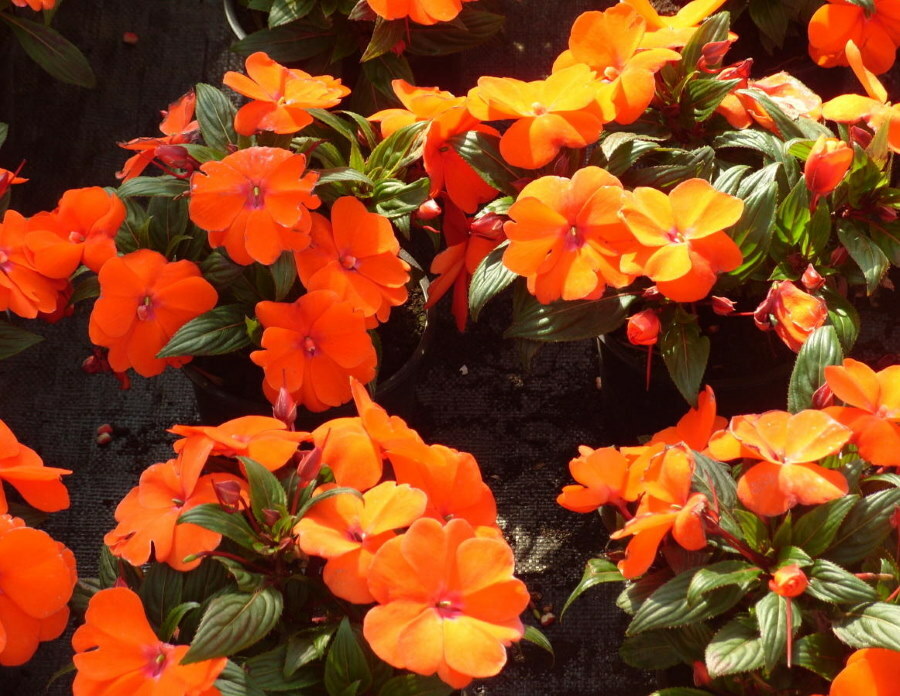
In the photo, New Guinea balsam of hybrid origin is a perennial, we grow in the open field as an annual plant
Among the novelties, it is worth paying attention to the lavender balsam "Florific", the decorative "Camellia": the hybrid Violet is purple, White is snow-white. Peppermint Stick (Camellia Peppermint Stick) is a variegated hybrid of scarlet color with characteristic stripes in the center of the petals.
Hybrids are propagated only with purchased seeds. When self-collecting seed, the result is unpredictable, species characteristics are not inherited by all plants.
Hawker's Balsam Impatiens hawkeri
In the wild, this species of balsam is found in the Solomon Islands and the coastal zone of New Guinea. A plant with a short stem, small flowers of intense color in white, pink, salmon-orange, carmine colors. The bush is spherical, grows well in the shade, does not tolerate direct sunlight.
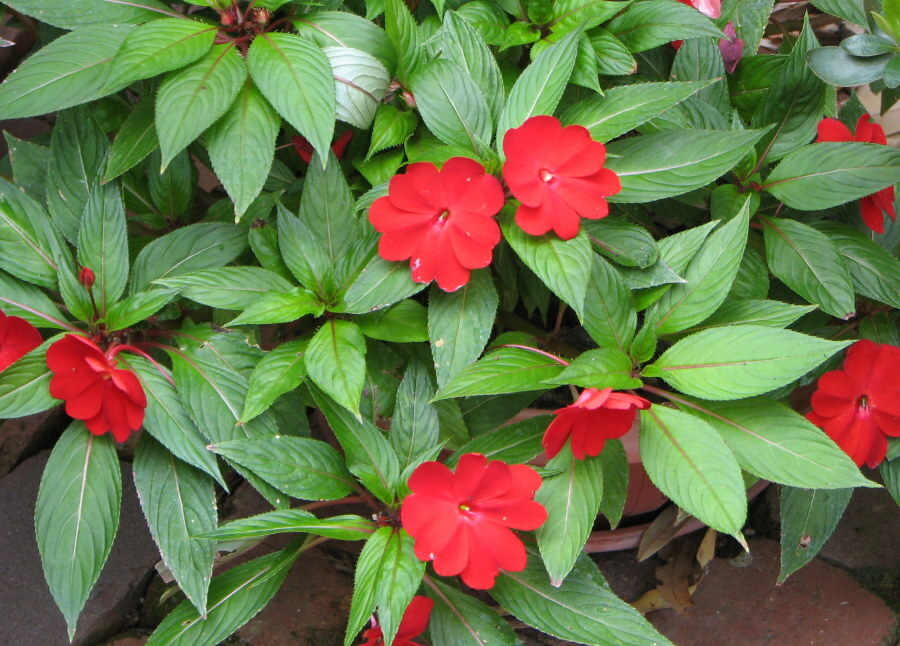
The flowers are quite small, but due to their bright color they look very impressive.
Regular removal of faded inflorescences before setting the seeds, pinching the shoots stimulate intensive budding, long flowering.
Balsam large-flowered Impatiens hookeriana or Impatiens grandis
The parent plant for selection was a wild plant from Sri Lanka with dark green leaves that have jagged edges. Large semi-double flowers grow up to 6 cm in diameter, the color of the petals varies. The bush is compact, hemispherical, up to 30 cm tall.
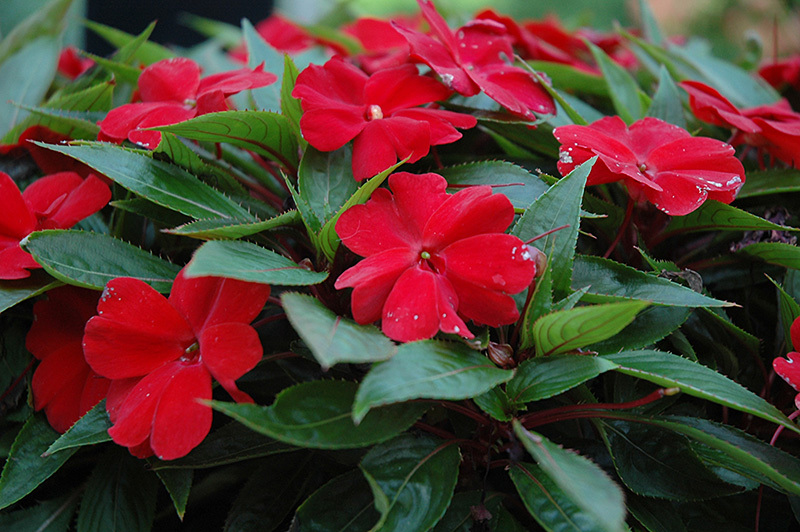
This type of balsam is appreciated by gardeners for its large flowers - white, pink or bright red
The plant is resistant to temperature contrast, not susceptible to fungal infections. Grows well in the suburbs.
Impatiens balsamina
For a combination of versatility, unpretentiousness to lighting and watering, the flower balsam is a garden native from India, China, the Malay Peninsula. The name comes from the peculiarities of the fruit pods, which instantly open with a light touch. Butterfly-like, carnation or rose-like buds appear at the tips of long shoots.
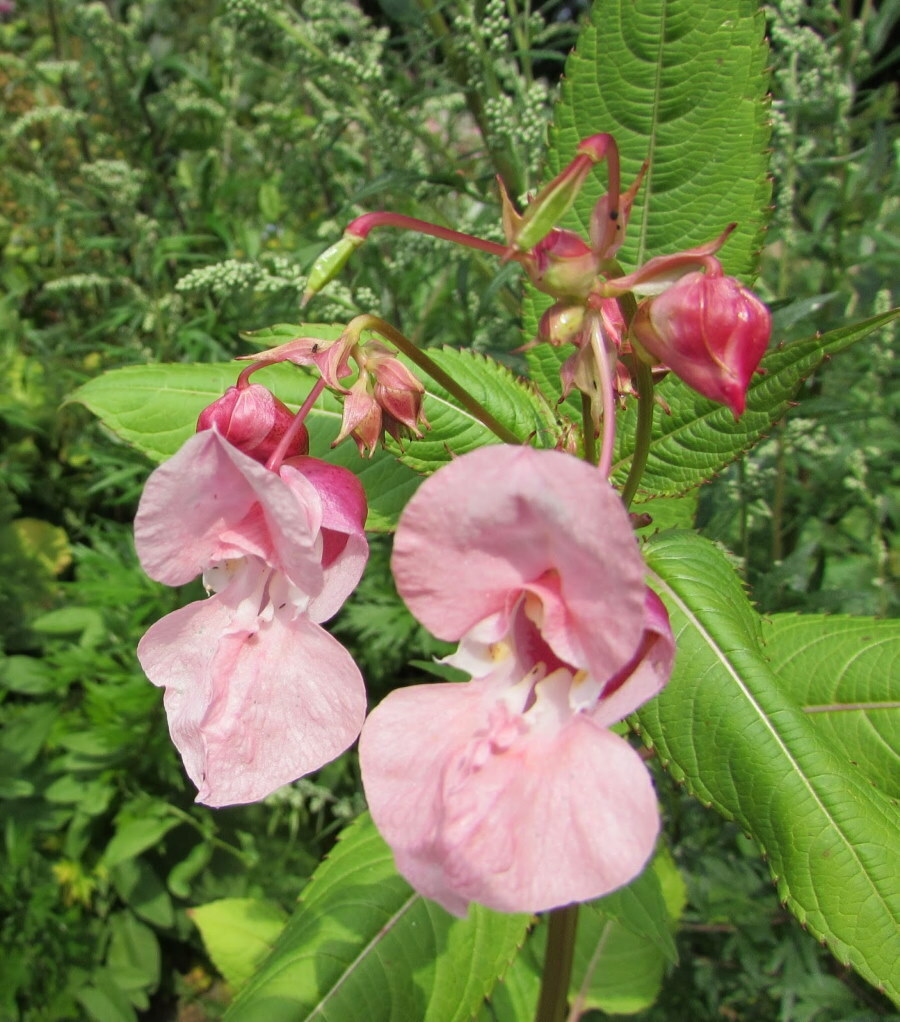
Balsamic touch-me-not - an annual plant with a thick stem up to 75 cm high
Colors: white, light pink, orange, red, purple. At home, the plant is used as a seasoning for meat dishes, added to salads for piquancy.
Small-flowered Impatiens Praviflora
The plant adapts well in the Urals, Siberia. Used for curb and solitary planting in shady places. Forms a dense head of buds, flowering duration - from May to late September.
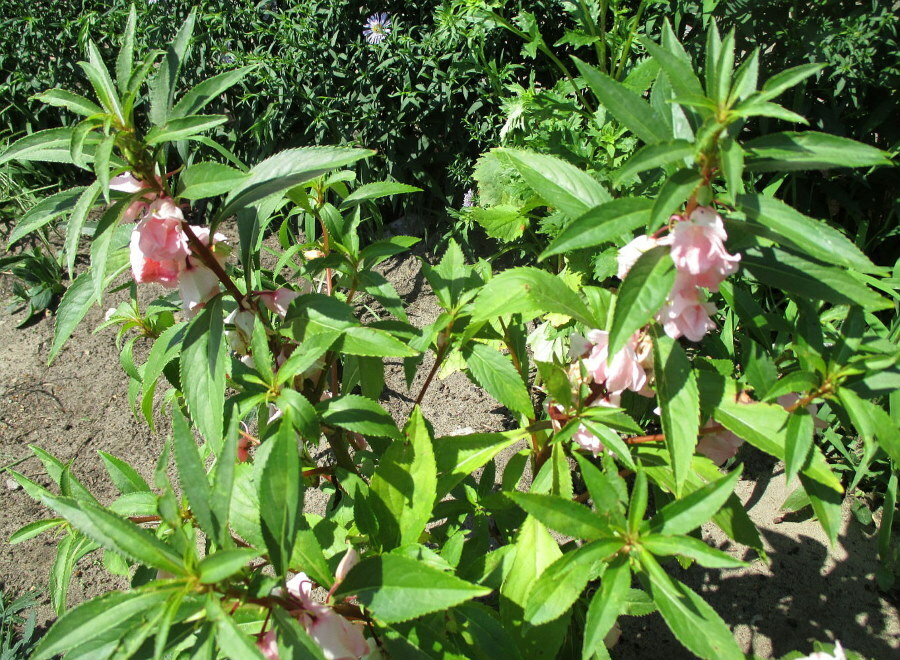
Small-flowered balsam - a plant with erect stems and pointed, serrated leaves
Hybrid of Impatiens walleriana
A heat-loving variety of balsamic native to Africa. In the tropics it grows up to 60 cm, in temperate latitudes up to 40 cm. Grows well in sunny areas and partial shade.
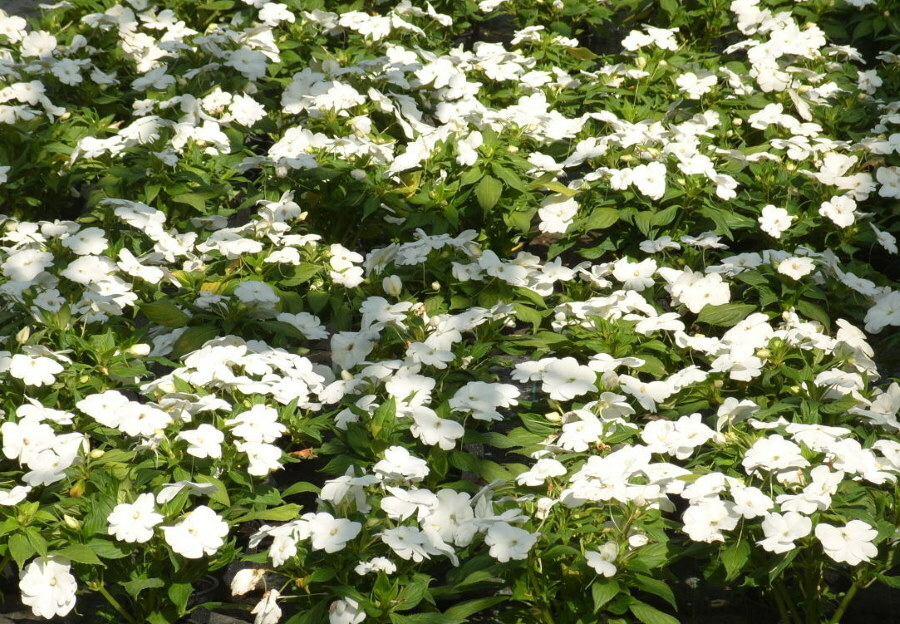
The flowers of Waller's balsam are simple or double
Among the semi-double, varieties of the Tom line are known, these are:
- pink balsam Tom Samb photo in the flowerbed;
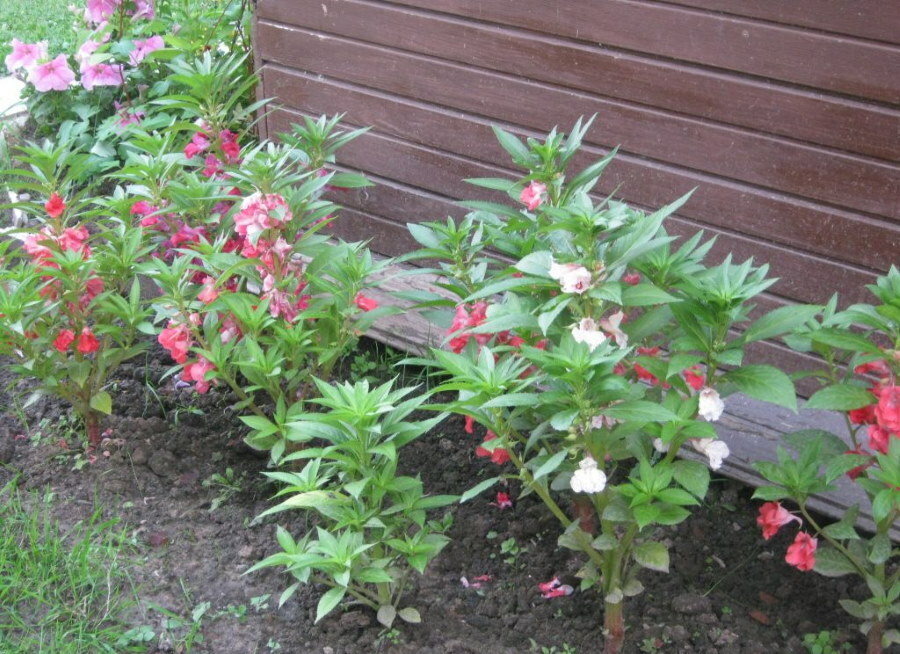
Flowering continues until the arrival of the first frost. Slightly larger bushes than many other varieties
- Thumb White in white;
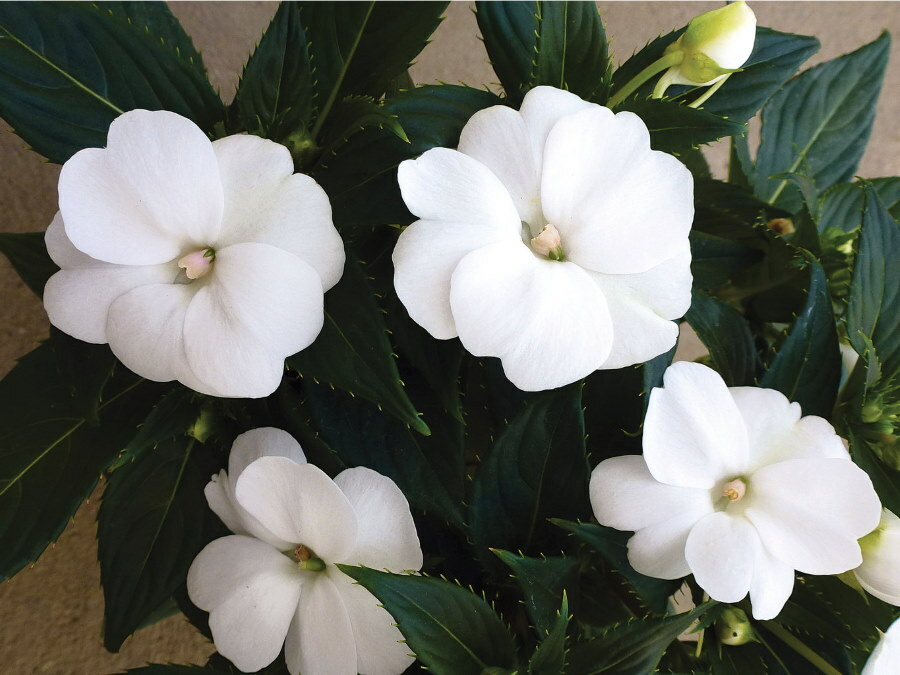
White flowers bloom on bushes about 20 cm high
- Tom Sambe Violet - bright purple in color.
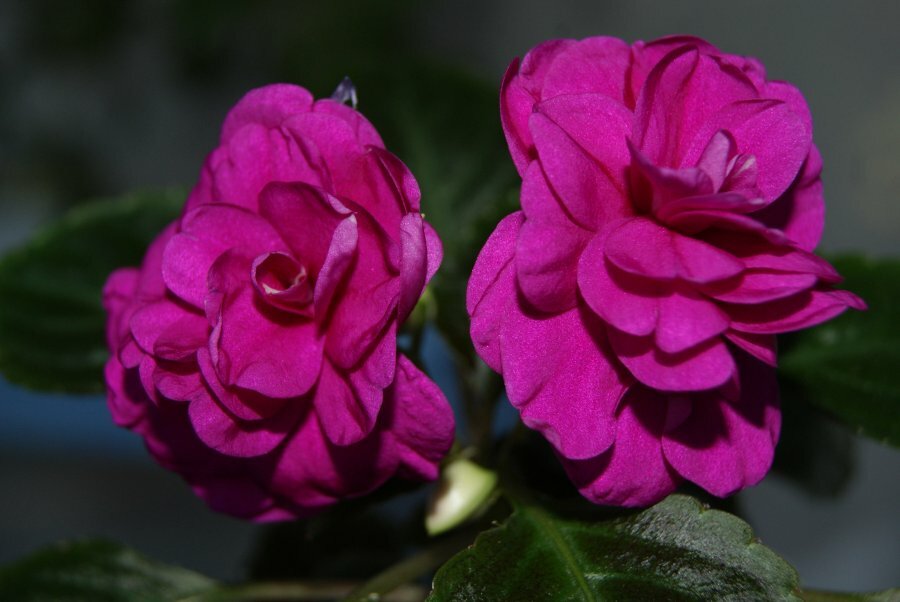
The variety is distinguished by a large number of purple buds that can bloom even in the shade of trees
Popular terry varieties: "Arabesque", "Pink Star", "Supernova".
Rules and recommendations for planting seeds
Usually, garden balsam is cultivated by cuttings and seedlings, planting and taking care of the photo does not take much time. Seedlings are grown at home at a temperature of 18-24 ° C. Seeds are planted in March-April, depending on climatic conditions. The optimum soil for planting is neutral, with a pH of 5.5–6.8. Choose a loose soil with good water permeability, rich in humus. A 1: 1 mixture of loam and humus is recommended with the addition of 1 part of sand or vermiculite.
You need to sow balsams without embedding. The seeds are laid out on a slightly crushed, moist soil. Spray from a spray bottle, cover with foil, remove to a warm place (up to + 27 ° C) until sprouts appear.
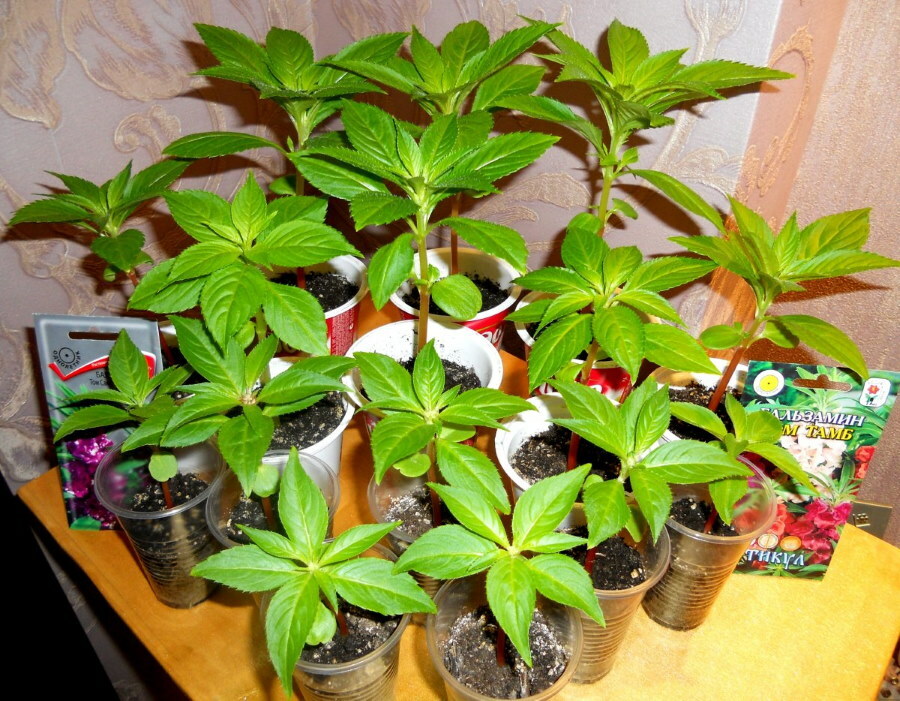
A month after planting, the seedlings begin to harden, accustoming the plants to open ground conditions. First, the pots are taken out for a couple of hours, then the time spent on the street is gradually brought to a whole day.
Features of flower care in a flower bed
To get richly blooming balsams in a flower bed, it is important to properly feed the plant. For feeding, it is recommended to add to the bucket of water:
- 1/2 cup wood ash or matchbox (20 mg) potassium fertilizer
- superphosphate 40 mg (box 2), double is needed 2 times less.
Minerals are often replaced with complex fertilizers for indoor flowers "Agricola". Top dressing is done together with watering twice a month.
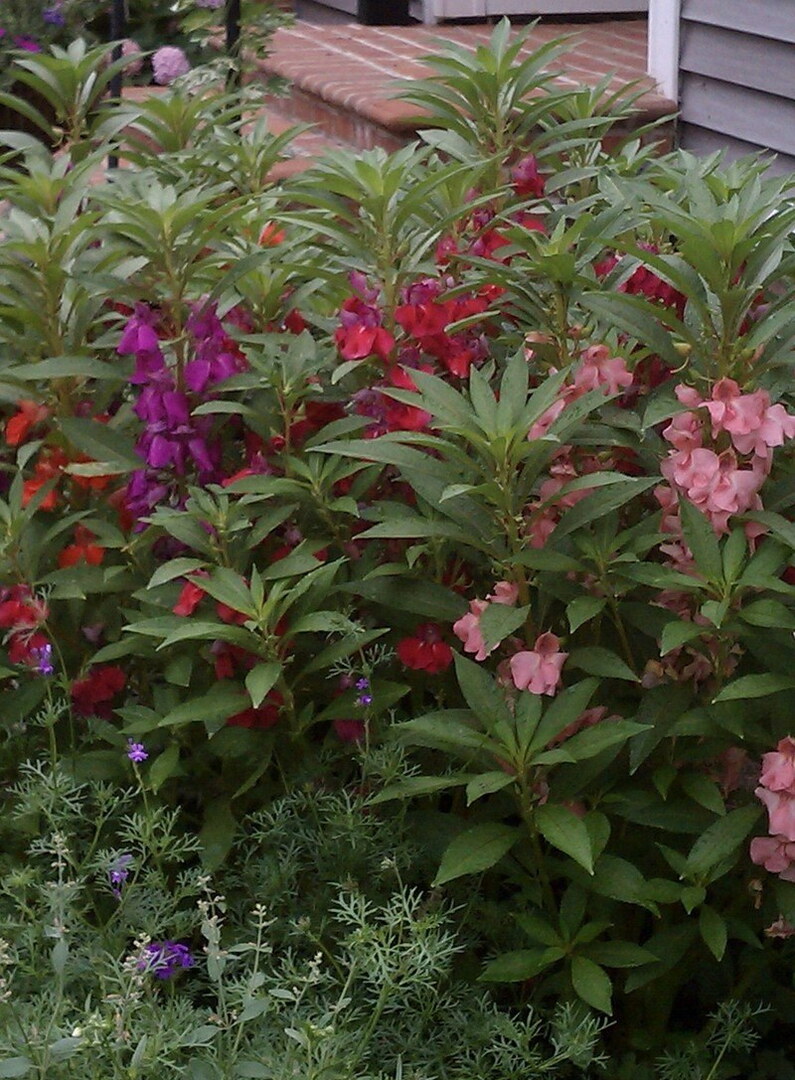
In hot and dry summers, plants need regular and abundant watering. It is good to spray the bushes with water in the evening
In addition, it is important to remove drying buds in a timely manner. A shaping haircut is carried out, if necessary, no more than once a season. For the winter, plants are brought into the winter garden or thrown into compost after frost appears, when the petals dry out.
Photos of examples of the use of a perennial flower
In a small selection of photos, various ways of decorating plots are presented. The use of balsam in landscape design is enormous. Huge compositions are made of flowers, planted on flower beds in groups and singly, used in rabatkas in personal plots. Various shades will emphasize the beauty of garden paths, building facades.
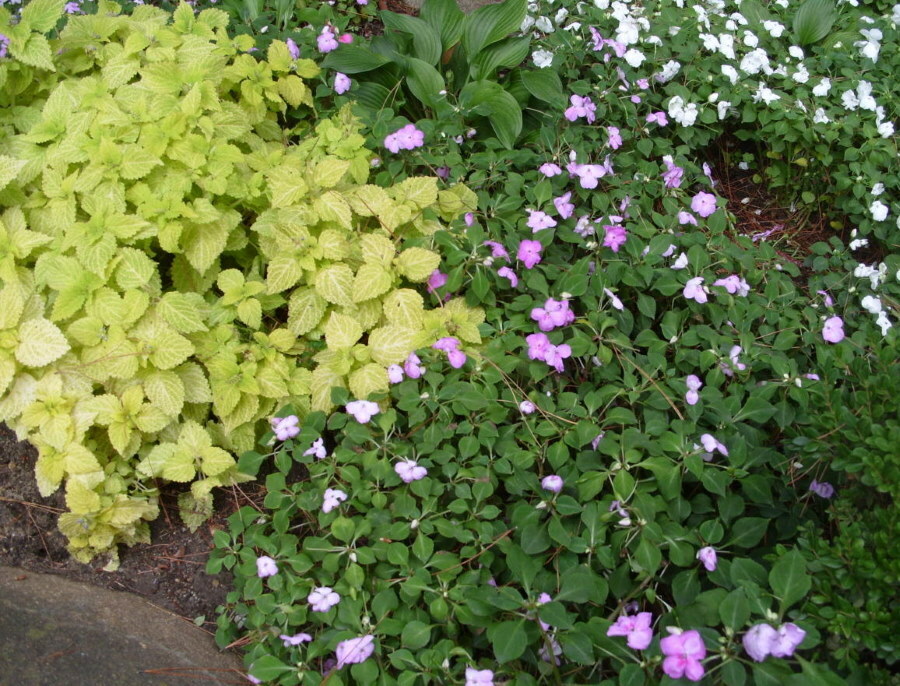
Contrasting duet of balsam with coleus
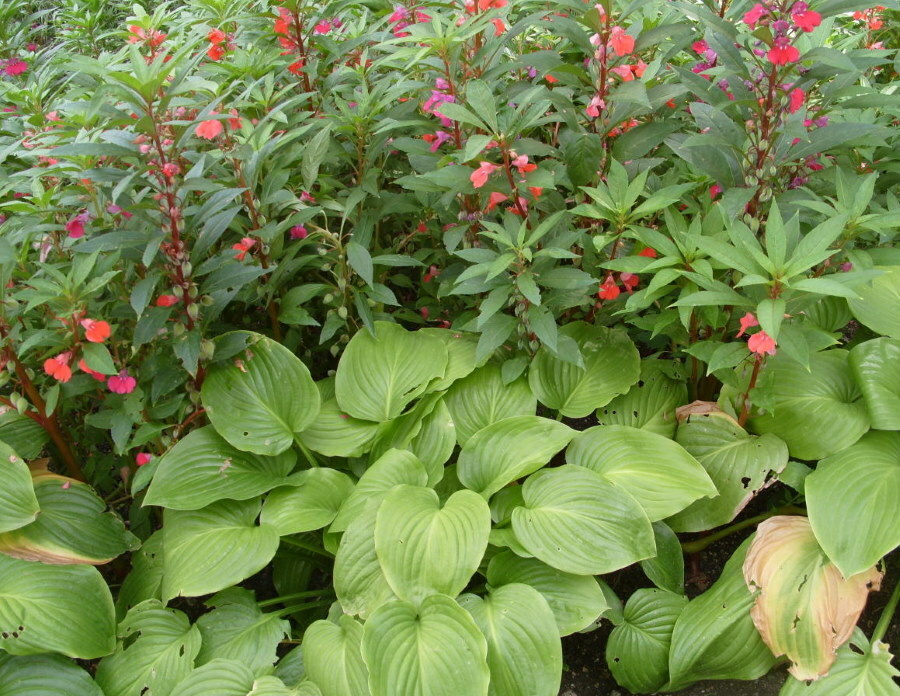
Tall balsams on the same flowerbed with the hosts
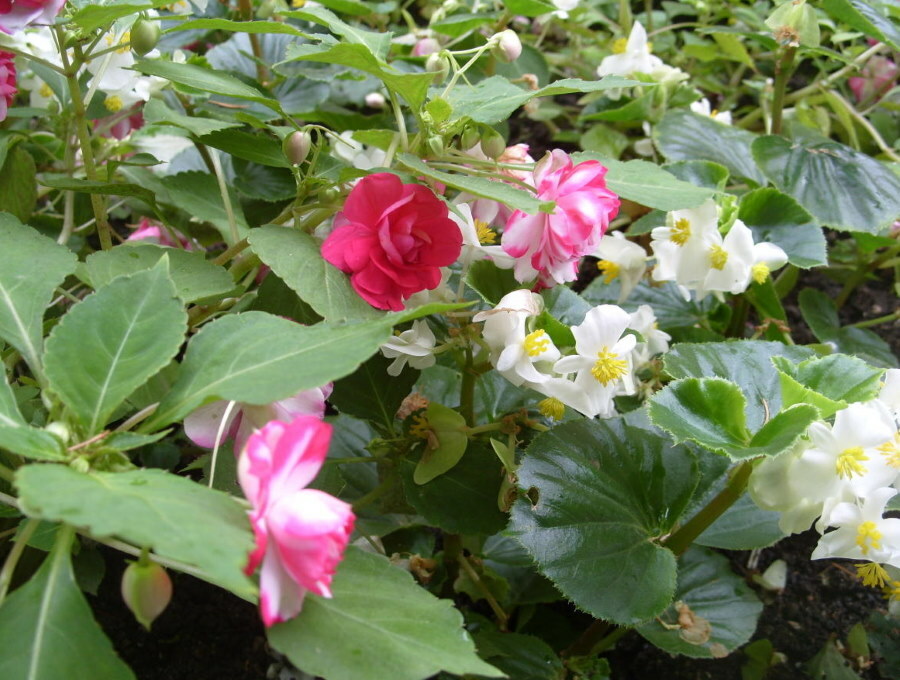
A spectacular combination of balsam and begonia


